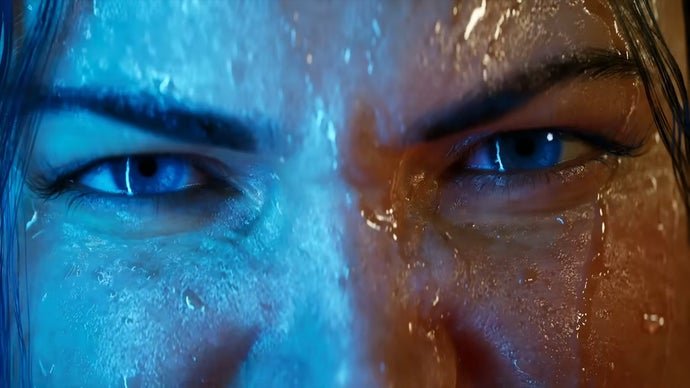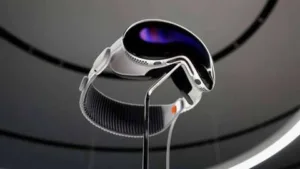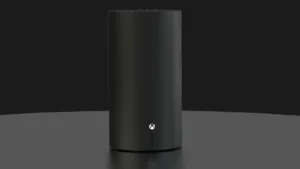Quantum Error Review
Quantum Error is the best modern example I can think of when it comes to a game that attempts to do so much and yet fails at almost all of it. The main exception is that, as a science-fiction horror game, it’s oozing with style and will find every chance it can to flash its moody, creepy world at you. It’s when you have to fight through it with shoddy gunplay against empty-headed enemies, sneak around with rudimentary stealth mechanics that barely work as advertised, or get up to the various door-chopping and fire-extinguishing tasks that impede your path to a dark secret, that you start to realize you don’t need to know much about theoretical physics to see the survival-horror shaped error sitting right in front of you.
The hero of this crooked tale of eldritch artifacts and the people they mutilate along the way is Jacob, a former soldier-turned-fire-safety-professional who’s got a lot going on but none of it makes him a memorable character. You’ll get lots of opportunities to exercise his trigger finger and his axe-swinging arms as he slinks through a locked-down mining facility on one of Jupiter’s moons that is equal parts Shadow Moses and Event Horizon. He’s a bland tea biscuit of a character with all the stereotypical 2010-era lead features, including the death of his brother driving his completely uncompromising and offputting need to save everyone all the time.
Surprisingly, it’s the firefighting segments that have the most potential here. There’s almost a job simulator sort of Zen to successfully venting rooms that contain active fires so that cutting through its door doesn’t get you fried by a backdraft, or chasing a gas leak fire to its source and clamping a pipe with the jaws of life to shut it down. Beyond that, however, the ideas flame out. Some other life-saving activities include using CPR to revive victims, complete with blowing into the DualSense mic to give the patient air, and escorting panicking people to safety, but these are more annoying than interesting. All told, there’s desperately little meat on this bone, and the disjointed little nibbles you get during the main campaign didn’t challenge me outside of making entering some rooms more complicated.
Surprisingly, it’s the firefighting segments that have the most potential here.
Traveling between the fire-branded, blood-soaked halls of the Monad facility is already pretty complicated though because it’s crawling with ravenous zombies and flesh-twisted monstrosities. Ironically, the living human enemies – mostly gunmen from the evil mercenary group, Medusa – are often more mindless than the reanimated corpses, walking in broken patrol loops or literally letting you walk right by them without much resistance. They can be evasive, especially if you catch one off guard, but they won’t put obstacles between them and your bullets for very long. Contrast that with the monsters, who come in various shapes and sizes but all basically just run at you, soaking up bullets like the world’s juiciest sponge. My 18-hour journey took me well beyond the halls of this facility, but be it on the surface of Neptune or deep underground in a Martian mine, the bulk of the resistance came from the same repetitive handful of enemy types. On hard difficulty, I didn’t find many creatures that were too tough to deal with, and I’d figure that has something to do with all the bad decision making they do with their higher damage and health.
I wouldn’t call anything about Quantum Error scary, per se. It’s definitely weird and sometimes unsettling to wander the halls and listen to the very bad things happening somewhere in the distance, or watching cutscenes that linger on an uncomfortable “are they possessed or nah?” smile or gaze for a little too long. But the most frightening occurrence I had was navigating tricky stretches of play between the unmerciful checkpoint placement. Outside of important events and cutscenes (determining what “important” means here is a crapshoot, as some events like boss introductions don’t make the cut) you can only save by visiting specific rooms and using a special machine, a la Resident Evil 2 or Alien Isolation. And that would be fine, except that it feels bad to lose any and all progress to an immensely cheap surprise like a completely invisible enemy sucking the air right out of your lungs from a corner in the room. That turns what could be a potentially 15-minute span of debris-clearing and face-beating into upwards of an hour depending on your resources and how well you can react to the next surprise.
It feels bad to lose progress to an immensely cheap surprise.
Every time you respawn, everything else respawns too, including health and ammo pickups – and any monsters on that floor that you’ve previously dispatched. This can make backtracking to stock up on alien-killing sundries a real chore, because they’re all back in full force. It’s also a bit buggy: on many occasions, I’d respawn but an event that’s happened to the station – like a full power outage triggered by entering a specific room several halls away – didn’t reset, meaning now not only did I have retrace all my steps and re-kill all these bad guys, but I’d have to do it in the dark.
It doesn’t help that many of these halls look just similar enough that you can get turned around with ease, and the maps (which you can only access at static positions on any given floor) are often unhelpful and, in some cases, incomplete. On at least two occasions this broke even further, flashing me suddenly into parts of the map and with enemies I would later learn I’m not supposed to see until many hours later. I don’t think these are the errors that the title was referring to.
I don’t think these are the errors that the title was referring to.
Stealth is said to be an option, but I found it to be mostly a waste. Enemies seem to have a supernatural awareness of your presence, sensing you from several rooms away between layers of walls and doors. You’ll see that they know you’re there, marked by a red icon in the bottom of the screen, long before you actually see them. Sometimes, this means bad guys will home in across some unknown stretch of the labs to punch your face. Other times, it means an enemy will walk in circles and never actually come get you at all.
The 3D audio is at its most inconsistent in these “tense” moments. Hearing lots of different sounds – distant footsteps from your right, a blazing fire behind you, alarms blaring all around – all at the same time can potentially be a good kind of disorienting, dulling your overall awareness so that crafty predators can slip between the audio cracks and sneak up on you. But in Quantum Error, it’s more often a bad kind of disorienting, with things that would be key information – like phlegmy enemy grunts or the high-pitched whines of doors opening – turning into chaotic cacophonies because a creature is pacing back and forth through a far-away door, stuck in a purgatory of if/then statements.
So I often chose to make a lot of noise myself, embracing the full plethora of firearms and firefighting tools that can double as weapons in a pinch. Even if it is the better option over stealth, gunplay is finicky. Much of the tension in combat comes from the battle you have to win against your unresponsive weapon wheels. It often takes multiple tries to even pull it up, and regularly ends up selecting weapons next to the ones I actually wanted.
The jaws of life are (somewhat ironically) a clutch melee alternative.
The weapons themselves work around as reliably as their counterparts in the dozens of games you’ve seen them in: a pistol with a silencer for quiet kills and clean ups, your shotgun for big power up close, sci-fi rifle for accuracy at longer ranges, etc. Very few guns in the overall arsenal break the mold in any way. An early find uses magma and four barrels to somehow be barely as useful as your regular, non-lava shotgun. Your heavy tools come in all shapes and sizes, though, and help in a pinch if you’ve run out of ammo and need to take threats down in melee. I found the jaws of life to (somewhat ironically) be a clutch melee alternative to swinging axes or hammers, as the clamp of the forks does tons of satisfying damage.
It’s the moments between combat or sneaking around that stand out. Quantum Error uses sparse lighting and lots of prestige horror-inspired camera work to really nail the creepy mood. There are so many long cuts, slow pans, and unsettling zooms that sometimes the cutscenes feel like an A24 fan letter. You’re going to see a lot of them over the campaign, some popping in at awkward times, slamming the action to a halt so fast that the hud and an occasional weapon sound may break into the presentation. Faces mostly look great, but textures on clothing and some surfaces are hazy. Even so, these cinematics will never ugly, even if some of the writing and acting felt cliche and predictable. There may be many twists and turns in this plot, but none of them proved interesting or ever surprising in the end.











Post Comment